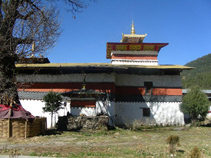
Tamshing Lhakhang
Encyclopedia

Bumthang District
Bumthang District is one of the 20 dzongkhag comprising Bhutan. It is the most historic dzongkhag if the number of ancient temples and sacred sites is counted...
of central Bhutan
Bhutan
Bhutan , officially the Kingdom of Bhutan, is a landlocked state in South Asia, located at the eastern end of the Himalayas and bordered to the south, east and west by the Republic of India and to the north by the People's Republic of China...
is the most important Nyingmapa temple in Bhutan. The temple and monastery are remarkable for their direct connection to the Bhutanese saint Pema Lingpa
Pema Lingpa
Pema Lingpa or Padma Lingpa was a famous saint and siddha of the Nyingma school of Tibetan Buddhism. He was a preeminent terton , and is considered to be foremost of the Five Terton Kings...
. It is now a seat of Lama Sungtrul Rinpoche the current speech incarnation of Pema Lingpa. Tamshing consists of a deteriorating temple and cramped monks quarters. The monastery supports a body of over 95 monks.
History
From an interview of Lopen Kharma, teacher and administrator of Tamshing Lhakang, conducted by Friends of Tamshing in December 2005:The temple was built by Pema Lingpa
Pema Lingpa
Pema Lingpa or Padma Lingpa was a famous saint and siddha of the Nyingma school of Tibetan Buddhism. He was a preeminent terton , and is considered to be foremost of the Five Terton Kings...
himself in 1501.
Before 1960 Tamshing was a privately owned temple (like many other temples in Bhutan). After Pema Lingpa died in the temple at the age of seventy-two in 1521, his descendants took over care of the temple. Gradually, over many years, Tamshing fell into a state of disrepair and neglect. The temple courtyard was used as a granary and local people came less and less, except for special days.
In 1959, when many Tibetans (including the present Dalai Lama) fled their country for fear of being killed quite a few came to the Bumthang region, which is the cradle of Buddhism in Bhutan.
In his time, Pema Lingpa received a vision to travel to Tibet where he revealed a treasure hidden by Guru Rinpoche (Padmasambhava
Padmasambhava
Padmasambhava ; Mongolian ловон Бадмажунай, lovon Badmajunai, , Means The Lotus-Born, was a sage guru from Oddiyāna who is said to have transmitted Vajrayana Buddhism to Bhutan and Tibet and neighbouring countries in the 8th century...
) many centuries before. He was given land in the Longti area of the Siti valley and built a temple there which is called Lhalung. This temple was later enlarged by his third (Tibetan) incarnation. Pema Lingpa travelled frequently to Tibet and most of his incarnations were Tibetan.
The 10th incarnation of Pema Lingpa died in Tibet shortly before the Tibetan diaspora. In 1960, a group of three monks from Lhalung monk body headed by Lhalung's second in command, Thinley Kuenchap (d. 1975) came to Tamshing to reestablish the Lhalung monk body at Tamshing.
Lopen Thinley Kuenchap was well known to the exiled Tibetan monks in Bhutan. Hearing of his arrival at Tamshing, many gathered there in late 1960 and established the current monk body. Over time, this group has grown from 10 or 15 monks to over 95.
When the Khudun, Lopen Kharma, came to Tamshing as a young boy in 1980, most of the senior monks from Tibet had passed on, however, Lopen Tseten who came from Tibet to Tamshing as a 10 year old monk in 1960 was still there. Today, Lopen Tseten is the head of the monastery organization and its senior teacher.
The present spiritual head of Tamshing is the 11th incarnation of Pema Lingpa, the Lama Sungtrul Rinpoche (speech incarnation) he was born in the Chumi Valley of Bumthang, Bhutan in 1967.
Tamshing today
The core missions of Tamshing are teaching the DharmaDharma
Dharma means Law or Natural Law and is a concept of central importance in Indian philosophy and religion. In the context of Hinduism, it refers to one's personal obligations, calling and duties, and a Hindu's dharma is affected by the person's age, caste, class, occupation, and gender...
, performing religious services for the community and educating the young monks under its care. Since Tamshing is not government supported it faces increasing challenges posed by supporting 95 monks while maintaining the ancient physical structures.
Mostly under the age of 15, the monks are either orphans or from very poor families who can't afford to send their children to a state school. As the economy of the country changes, and as the culture becomes more outward looking, it is inevitable that some of the old ways of supporting the temples and monasteries, (which are the repositories of traditional wisdom), are being tested.
Tamshing has no endowment; no mission to make money, its only mission is to meet the needs of the community. Currently, the monastery runs at a loss.
Tamshing and Bhutanese Dance
Tamshing is the original home of sacred dances that are celebrated at traditional TsechuTsechu
Tsechu are annual religious Bhutanese festivals held in each district or dzongkhag of Bhutan on the tenth day of a month of the lunar Tibetan calendar. The month depends on the place, but usually is around the time of October. Tsechus are religious festivals of Drukpa Buddhism...
s (festivals) throughout Bhutan. According to Joseph Houseal, director of Core of Culture Dance Preservation:
"Dance...is the living tradition of their founding identity and the means by which Pema Lingpa sought to teach the world Buddhism - and the treasure he specifically left the Tamshing monks. It is the life of the order, the Buddhist truth they maintain. That is one reason we have focused on Tamshing: their dances were revealed by the most famous Bhutanese saint, and Tamshing alone performs the dances correctly..."

